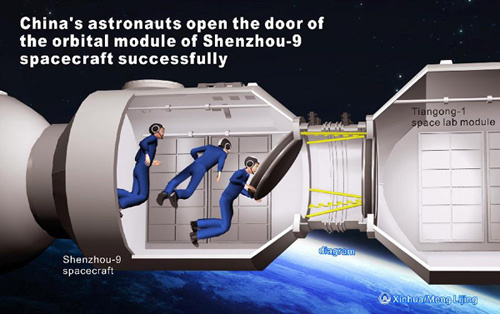
The graphics shows China's astronauts opening the door of the orbital module of Shenzhou-9 spacecraft successfully, after the automatic docking of Shenzhou-9 spacecraft and Tiangong-1 space lab module on June 18, 2012. (Xinhua/Meng Lijing)
Three Chinese astronauts floated into the cabin of an orbiting module Monday afternoon, becoming the first group of Chinese to enter an orbiter in space.
Jing Haipeng, followed by Liu Wang and Liu Yang, went into the space lab module Tiangong-1 from spacecraft Shenzhou-9 about three hours after a successful automatic docking procedure which was completed at 2:07 p.m.
"Shenzhou-9 crew members feel great!" reported astronaut Liu Wang to the Beijing Aerospace Control Center.
Live television broadcast showed the three astronauts in blue uniform waved to the camera inside the Tiangong-1 cabin against the backdrop of a five-starred national flag and a big red Chinese knot.
They are the first tenants in the 15-cubic-meter cabin of Tiangong-1, known as "Heavenly Palace."
The 8.5-tonne space lab module has been traveling around Earth for 262 days since it was launched in September 2011.
"The real test will be the manual docking attempt six days later," said Zhou Jianping, chief engineer of China's manned space program.
"A manual docking, if successful, will demonstrate the country's grasp of essential space rendezvous and docking know-how," he said. "It will mean China is fully capable of transferring human and cargo to an orbiter in space."
A manual docking is considered as a major step forward in China's manned space program to build a space station around 2020, in time for the likely retirement of the International Space Station.
Besides manual docking, the astronauts will conduct medical experiments and other space tests during the current mission.
China succeeded in an automated space docking between unmanned spaceship Shenzhou-8 and Tiangong-1 late last year.
The three astronauts, including the country's first female astronaut Liu Yang, were sent into space by an upgraded Long March-2F carrier rocket from the Jiuquan Satellite Launch Center in northwest China's Gobi dessert at 6:37 p.m. Saturday.
"China looks forward to more international cooperation in future space explorations," said Lu Xinguang, a leading designer of the control system of China's carrier rocket.

Copyright ©1999-2011 Chinanews.com. All rights reserved.
Reproduction in whole or in part without permission is prohibited.